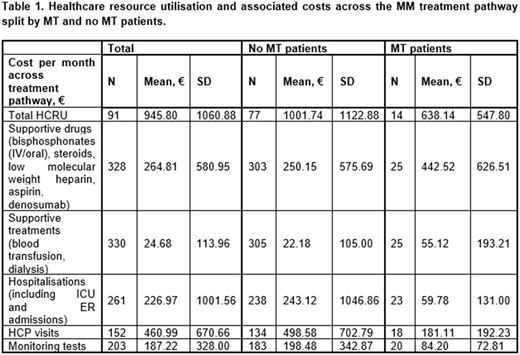Abstract
BACKGROUND
Recently introduced treatment options, including the introduction of maintenance therapy (MT) post ASCT, have significantly improved outcomes and life expectancy of MM patients. To date, the impact these treatment options have on healthcare resource utilisation (HCRU) has not been assessed.
AIMS
The aim of the analysis was to determine current management of post-ASCT NDMM patients in terms of outcomes, HCRU and the associated costs in Europe for patients receiving either MT or no MT.
METHODS
A retrospective chart review was conducted in France, Germany, Italy, Spain and the UK in Q1 2017. Physicians provided data on consecutive patients with MM who had undergone an ASCT as part of first-line (1L) treatment on or after 1st January 2014; HCRU data was collected post initial ASCT until the end of follow-up. Mean follow-up time for patients was 18.2 months (21.2 vs 18.0 months for patients receiving and not receiving MT post initial ASCT, respectively).
Data collected pertained to patient characteristics, treatment patterns, duration of treatment and outcomes (including time to progression [TTP] estimated based on Kaplan-Meier method), HCRU post initial ASCT including: supportive drugs, other supportive treatments (blood transfusions and dialysis), hospitalisations, healthcare professional (HCP) visits and monitoring tests conducted, but excluded cancer drug costs.
Costs were applied to the relevant resources consumed. Tariffs from a single-country health service (the United Kingdom) were applied; an exchange rate of £1 to €1.1365 was used (correct as of 1st July 2017). Cost for hospitalisations, HCP visits, supportive treatments and monitoring tests were obtained from the NHS Schedule of Reference Costs (2015-2016), and supportive drug costs were obtained from MIMS 2017. The costs have been applied to data collected from the healthcare system perspective, thus allowing for a broad overview to assess the impact of MT on HCRU across treatment lines post 1L ASCT. Monthly resource use was calculated for the duration of the follow-up time for patients.
RESULTS
Fifty-one physicians completed record forms for 337 patients. Fifty-seven percent of patients were male; mean age at diagnosis was 58.7 years (± 7.7 SD). Mean duration from diagnosis to receiving an ASCT was 9.8 months (± 13.2 SD). Of the patients included in the study, 61%, 27% and 9% had received up to 1L, second-line (2L) and third-line (3L) therapy, respectively; 3% of patients also went onto receive ≥ 4 lines. In the 1L setting, 93% of patients did not receive any MT post ASCT; 7% received MT. Of the patients who did not receive MT, 40% and 12% went on to receive 2L and 3L therapy respectively, whereas only 20% of patients who received MT went on to 2L and none on to 3L. The most frequently prescribed regimens at 1L MT were lenalidomide (88%), bortezomib (8%), and thalidomide (4%).
The mean TTP from start of 1L therapy was 30.0 months (95% CI: 27-32 months; n = 312) for patients not receiving MT and 39.0 months (95% CI: 31- months; n = 24) for patients receiving MT.
Of the 337 patients, 91 had complete resource use data across their treatment pathway. The total cost of HCRU post 1L ASCT per patient was €945.80 per month; patients receiving MT (n = 14) had an associated HCRU cost of €638.14 per month, whereas patients not receiving MT (n = 77) cost €1001.74 per patient per month. Over the course of the treatment pathway, the level of HCRU consumption varied depending on the type of resource (Table 1). Patients receiving MT required a higher level of supportive drugs (€442.52 vs €250.15 per patient, respectively) and other supportive treatments (€55.12 vs €22.18, respectively). However, the utilisation of other resource data captured was higher for no-MT patients vs MT patients (hospitalisations: €243.12 vs €59.78; HCP visits: €498.58 vs €181.11; monitoring tests: €198.48 vs €84.20 per patient, respectively).
CONCLUSION
The patient sample observed within this real-world study is reflective of the patient demographics data reported in Raab et al. 2016. The TTP data for patients not receiving MT post ASCT at 1L is comparable to recently published pooled PFS data from large RCTs. The data presented indicates that the use of MT therapy at 1L defers future treatment lines, therefore reducing the overall monthly HCRU cost relating to hospitalisations, HCP visits and monitoring over a patient's MM treatment pathway.
Ashcroft: Celgene: Consultancy, Honoraria, Speakers Bureau; Amgen: Honoraria, Speakers Bureau; Janssen: Consultancy, Honoraria, Speakers Bureau; Takeda: Consultancy, Honoraria, Speakers Bureau. Dhanasiri: Celgene Corporation: Employment, Equity Ownership.
Author notes
Asterisk with author names denotes non-ASH members.


This feature is available to Subscribers Only
Sign In or Create an Account Close Modal